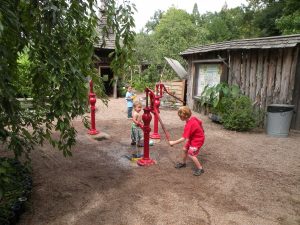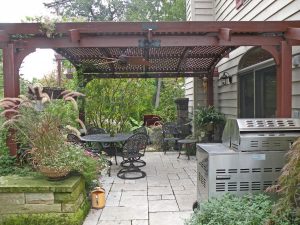
Red water pumps in mud pie area
All plants and no playfulness make gardens dull spaces. By incorporating a little imagination, we can create areas that are enjoyable for both kids and adults. Keep in mind that children love to get dirty and providing small areas where they can play with water and make mud pies would be quite desirable from their point of view. For your sake, there should be a hose, a bench, and a towel nearby.
There are a variety of books that address the topic of creating gardens for children. However, lot sizes are diminishing, making it increasingly difficult to set aside space specifically dedicated to playtime. In addition, the landscape needs to evolve as children grow and mature. The following suggestions can help you create spaces that stimulate children’s imagination while giving you, the parents or grandparents, a grown-up place to relax.

Child-sized arch
Creating Comfort: Incorporating an arch or arbor into a landscape can add a touch of elegance as well as a focal point. Most of these structures, however, are at least six feet tall. Although great for adult guests, the size of these features can sometimes make small children feel uncomfortable. Why not create a secondary path that leads through a smaller archway? Such a feature can make children feel special and still maintain adult space.

The child-sized chairs echo the aesthetic of the adult chair.
Many homes today have decks or patios with seating for residents and guests. With this in mind, why not set aside a small area that includes seating and tables that are child-sized? The children will be more comfortable and thus better able to enjoy each other’s company.

This pergola could be enhanced with a vine that interests children.

The tomatoes growing on this arch can be picked by children or adults, depending on their height.
If decks or patios are sited in bright sunlight, some shade or the illusion of shade can be provided by tepee-like poles or pergolas. Children would be more invested in the space if given the opportunity to help select which vines should grow up and across the poles. There are a variety of choices, ranging from Convolvulus annuus (Morning Glory) cultivars such as ‘Flying Saucer’ and ‘Tie Dye’ to Dolichos lablab (Hyacinth Bean) that has bright purple flowers and beans. Two other options include Phaseolus coccineus (Scarlet Runner Bean) and cherry tomatoes. Most of these plants can be used as a learning tool for children about food production.
Creating gardens for children is a huge topic so I’ll have more to say in some following posts.


0 Comments